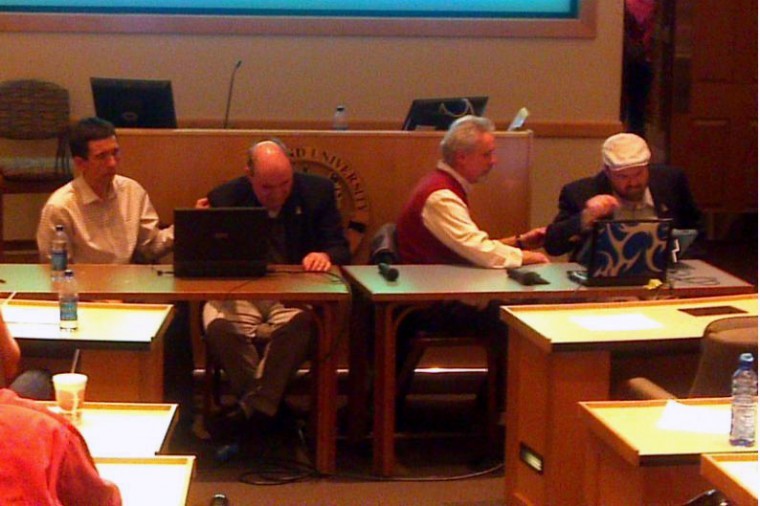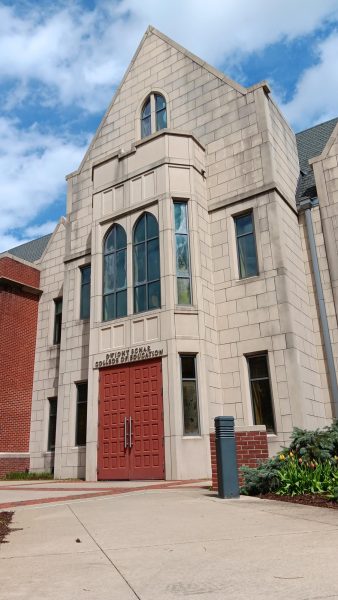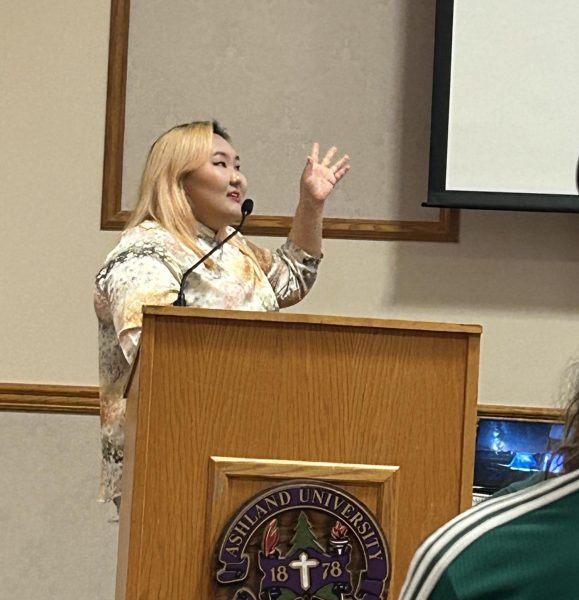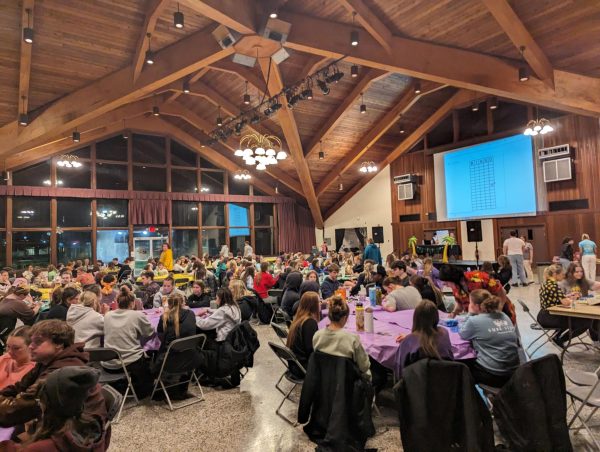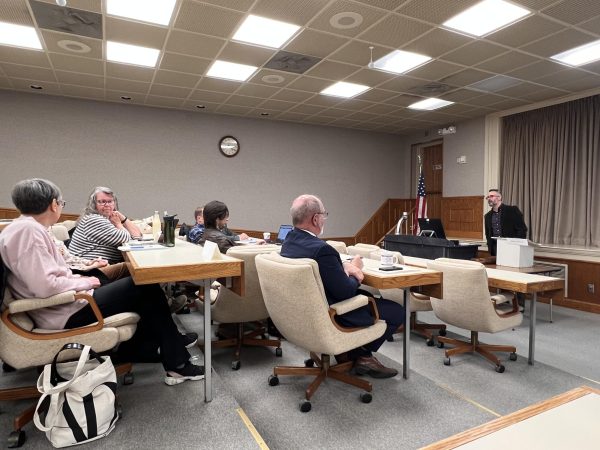Autism speaks at AU
April 21, 2011
As the 52-year-old man left the auditorium, he stopped in the doorway, pausing for a moment. Placing his hand up against the smooth wood of the door, he leaned in close with his head tilted as if to smell it. It was as if he was soaking up this moment, his moment. Perhaps Zooey Deschanel sang it best, “The touch, the feel, the fabric of our lives.”
Larry Bissonnette knows a lot about soaking up moments in life. He is a passionate food-lover and greatly enjoys drinking Bud Light. He also has a great sense of humor and often works his love of alcoholic beverages into his conversations.
“Thanks for making it out when you could be at happy hour,” Bissonnette joked to the audience in the Ronk Lecture Hall Friday night at Ashland University. After the audience’s laughter subsided, they all stared at the word document on the projection screen above Bissonnette’s head, waiting to see what he would type next. Why weren’t they eagerly staring at Bissonnette, waiting to hear what he would say next? Because Larry Bissonnette is autistic.
Bissonnette and his friend, Tracy Thresher, recently had a documentary made about their lives and how they deal with being autistic. During the filming of “Wretches and Jabberers,” Bissonnette and Thresher traveled to Sri Lanka, Japan and Finland to meet with other autistic people struggling to find their voice. The documentary was viewed by Ashland’s community members and students Friday night, followed by a question and answer session with Bissonnette and Thresher, as well as their assistants.
Autism is a developmental disorder that appears in children at a young age and effects social and communicational growth in the brain, according to http://www.ncbi.nlm.nih.gov/pubmedhealth/. While this is the definition of autism, Bissonnette and Thresher strive to show others that they not only badly want to communicate and have social lives, but are also more than capable of doing so.
Conversations in the traditional sense are difficult because Bissonnette and Thresher have a hard time speaking. One of the ways that they converse is through the use of laptops or iPads. When they are done typing their answers, questions and comments, they have their machines read the sentence out loud.
Another way that Bissonnette and Thresher converse is with the help of communication assistants. Bissonnette’s assistant is Pascal Cheng and they have been working together since 1991. Thresher’s assistant is Harvey Lavoy and they have been working together since 1994. The four men share a special friendship, which was only strengthened as they traveled the world together.
When the four men arrived in Sri Lanka, they met with an autistic man named Chammi and his mother, Anoja. Chammi and Anoja were looking for ways to help improve education about autism in Sri Lanka. Chammi spoke with Bissonnette and Thresher about his struggles and the frustration he felt at his inability to accurately convey what he wanted to say.
A lot of times, Chammi would have to walk away from his laptop while he was trying to type due to the anger and irritation he experienced. People with autism often exhibit signs of over-sensitivity in sight, touch or hearing, experience unusual distress when routines are changed, or perform repeated body movements, according to Pub Med Health. Chammi often struggles to type because of his inability to keep his arms steady. This would result in missed keys or misspelled words. Sometimes answering a question or asking for something takes Chammi a very long time to do.
Lavoy explained that this is why he assists Thresher with his typing conversations.
“Just a touch helps with focus and encouragement,” Lavoy said. “It’s an emotional kind of thing. For example, Tracy [Thresher] kicks to the right [with his arms].” By touching or assisting Thresher, Lavoy helps keep him on track, focused and relaxed during his conversations.
Many autistic people struggle with this and no one understands better then Thresher.
“People all want communication,” Thresher said. “I have always been angry about my autism.”
When Bissonnette, Thresher, Cheng and Lavoy traveled to Japan, they met with 16-year-old Naoki and his mother, Miki. Naoki has authored 11 books and is an excellent writer and artist. However, despite his obvious talent and intelligence, and because of his autism, Naoki is not permitted to attend local high school and is homeschooled by his mother. In the 1980s, most autistic children were excluded from regular schooling and there are still instances of this today. This was a fact shown in “Wretches and Jabberers.”
Bissonnette can relate to Naoki in more ways than one. Not only does Bissonnette live through the frustration and misunderstanding of autism, but he is also an artist. Bissonnette has a studio and owns a Polaroid camera.
He takes headshots of the people that he meets on his journeys and then goes back to his studio and tapes them to his canvases. He then uses those headshots as inspirations to paint abstract pictures with vibrant colors.
Henna is an autistic girl who lives with her mother, Annita, in Finland. When Bissonnette and Thresher traveled to meet with her, they all sat around a large wooden table and set up their laptops. They typed back and forth to each other about how they feel about being autistic. Bissonnette talked about the wrong ideas people get about autistics. Bissonnette said that the most common wrong idea about autistic people is that they have poor social skills because of poor intelligence.
Because of the impression of lower intelligence that Bissonnette and Thresher feel are pressed upon them, they both search for deeper meanings in their lives.
Bissonnette finds a lot of peace and meaning through his artwork, but his artwork came after a long time of pain. When Bissonnette was a small child, he was misdiagnosed as schizophrenic and placed in a mental institution. He said that, as a kid, he couldn’t figure out what he had done wrong. Once he was correctly diagnosed and released, he began painting. He finds worth in it and feels that other people find worth in it too, hopefully closing the gap between misunderstanding and understanding.
Thresher is still searching to find some peace and purpose for his life. Thresher has no permanent home and lives out of book bags, shifting between houses. When he was in Sri Lanka and Japan, he visited temples and talked with Buddhist monks, seeking guidance and advice about how to find meaning in his life. After listening to the things that the monks had to say, Thresher felt that his search for understanding and meaning was being pushed in the right direction.
There are many things that people need to understand about autistic people and the way they feel.
“Being autistic is not an abnormality of the brain; it is an abnormality of experience,” Bissonnette said. He is hoping that people understand that autistic people are not dumb; they simply have not had the opportunities to interact and learn like others may have.
He said that he couldn’t convince anyone that he had an inner life that didn’t shine through to his outer life, until he started typing to communicate.
When Bissonnette was asked how he felt about being misdiagnosed and misunderstood as a young child, he explained that he isn’t bitter, only hoping that his experience helps others realize the problems that still exist in the medical field, as well as in society.
“That tells the story because labels put up barriers between people that only exist in a medical manual,” Bissonnette said. “We are all human beings that feel and think within spectrum. That’s the short answer.”
When asked his advice on how to help others with autism start communicating, Thresher explained that people and technology are key.
“I would presume competence first…do joining of competence with method of dealing,” Thresher said. “Support training, technology and patience, and lapping up tips from a skilled trainer.”
The information and experience that Bissonnette, Thresher, Cheng and Lavoy brought to AU was successful and touching, which was proven when their documentary screening ended and the whole audience rose in a standing ovation to show their appreciation and admiration for the four men quietly sitting in the back of the room. As they moved down to the front to take questions from the audience, Bissonnette joked that he couldn’t buy drinks for everyone like he would have liked to.
“Nothing on me,” Bissonnette said. “Movie stars don’t carry money.”
And that’s really just the kind of guys Bissonnette and Thresher are.
Striving to promote understanding and acceptance, while still searching for themselves and the meaning behind their lives with the hand they have been dealt, is what these men do every day.
But they keep their great sense of humor and continue to smile.
As Thresher said: “We are the perfect example of intelligence working itself out.”


